Tour of the Settlement Print Shop
Florida Pioneer Settlement for the Creative Arts, Inc.
1776 Lightfoot Lane
Barberville, Florida
Near intersection of Fla. Hwy 40 and US 17
Just 6 miles north of DeLeon Springs, near Historic DeLand, Florida
For more information about the Settlement Print Shopor the Florida Pioneer Settlement call:
(386) 749 - 2959
The Settlement Print Shop is a fully facilitated letterpress operation situated near Lemmon Steet, right behind the Old Church, by the wagon house. We feature presses and printing equipment typical to the era we represent, 1880 - 1940. While many new technologies were growing by leaps and bounds in that 60 year span, the printshop of the small southern communities remained remarkably unchanged. Our presses are completely manual, as is our iron paper cutter and line perforator. Our type must be hand set. Our paper must be shipped in from the nearest large town. Our three presses must be ready to print everything from the local newspaper to the sunday Order of Service for the old church. Or raffle tickets. And, during the war between the states, these offices even printed postage stamps and pre-paid envelopes, such as one of America's rarest Post Office "Provisionals", which was printed from a shop such as ours in New Smyrna.
We are a working print shop, and on a wednesday or saturday you will most likely find me printing a client's order. Or receiving inventory, composing type, cutting stock for the next order, or just oiling those iron devices which makes our printery work.
Feel free to stop by any time the shop is open, and set a spell and chat a while ( in very unauthentic air conditioning.), reminisce, or just watch the operation. If you would like, you can even take the wheel yourself and make a few impressions to remember the visit by.
To date, all of our presses are common variety "Gordon" type vertical platten presses which were the workhorses of the "Jobber" Printing industry since the War between the States. We use two 8 x 10 Chandler & Price Old Style presses and one 12 x 18 New Style. We also have a growing Kelsey Hand Press collection. Currently we are sorting thru about 75 drawers of type which came from several sources. Our Print Shop is a work-in-progress.
At this time, i wish to recognise support given us by DeLeon Spring's own A.O. Painter, Inc., one of the oldest printing concerns in Volusia County, which produced Orange City's first News Paper, located on US 17 in downtown DeLeon Springs, not far from the State Park. Also the DeLand News Journal, and other contributors who not only helped us with their donations and good will, but also in getting the word out about our presence in the community and state.
We now begin our short virtual tour of the Settlement Print Shop and some of our product samples:
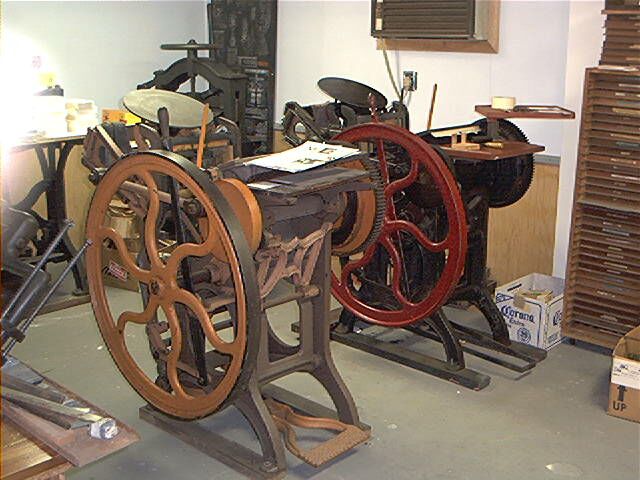
The frontmost (orange) press is actually c. 1885. The red press, which is actually the workhorse of the shop, most likely dates closer to 1900. To date, all of the Amateur Radio "QSL" cards that we have produced came from this 104 year old beauty.
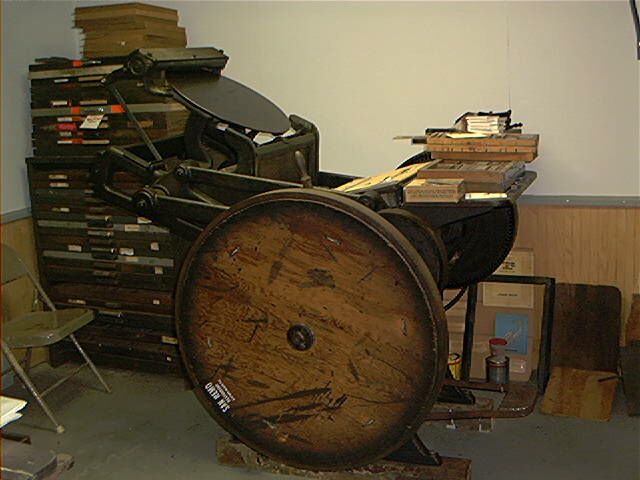
Nick-named "Casey", it's about the size of a small Locomotive. Actually considered one of Chandler and Price's medium sized offerings at 2800 lbs, it is capable of printing anything from broadsides to books in quatro. We will be printing the Settlement Newspaper on this press. It was once clutch-coupled to a steam conveyor. Believe it or not, this big fella is a treadle press. All our presses are manually powered.
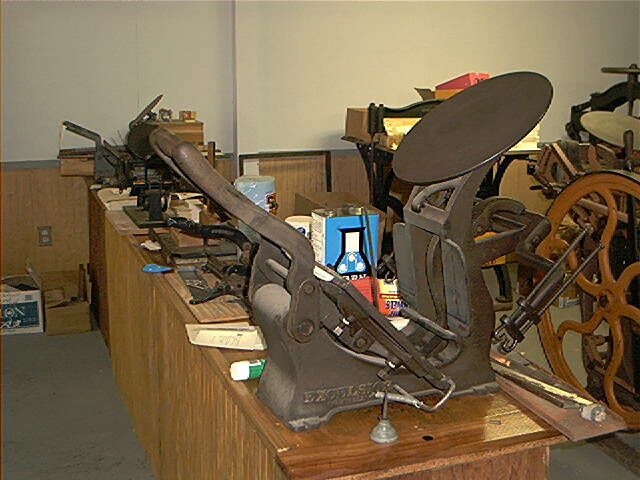
Fronted by the 9x13 Excelsior "F",c.1903
Never be fooled by the table-top iron presses of Chicago or Kelsey. These are full blown presses in every sense of the word. The 9x13 iron handpress in the foreground was probably the largest production iron handpress in North America, and prints a larger area than the top two 8x12 C&Ps. These were used by your's truly for printing Christmas and greeting cards as part of Heirloom Press, my former operation in Palm Harbor, Fla. Gives "pumping iron" a whole new meaning!
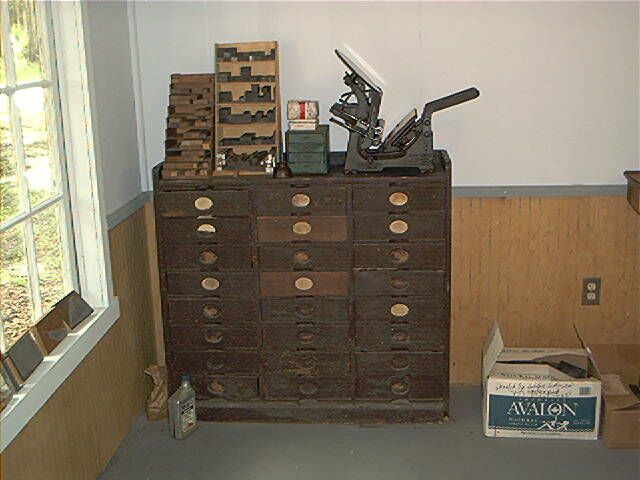
This is the little press i take along to exhibitions like the Antique's Road Show, lately video taped for broadcast June 8th 2004 by Daytona's WCEU.
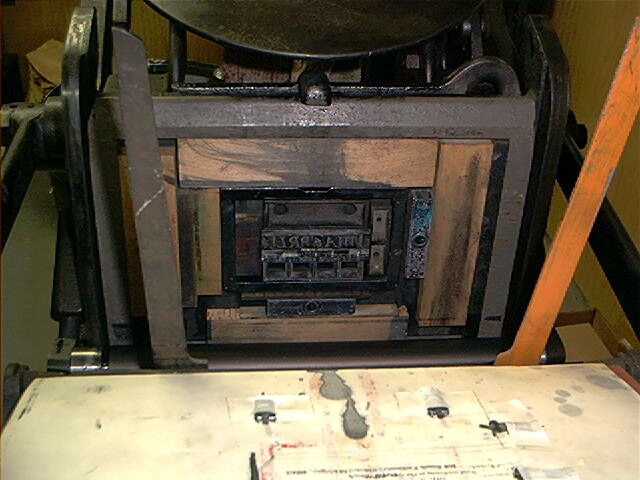
This is the QSL Card call letter and personal info. It is being run separately, being imprinted onto the "shell" which was printed during the first run.
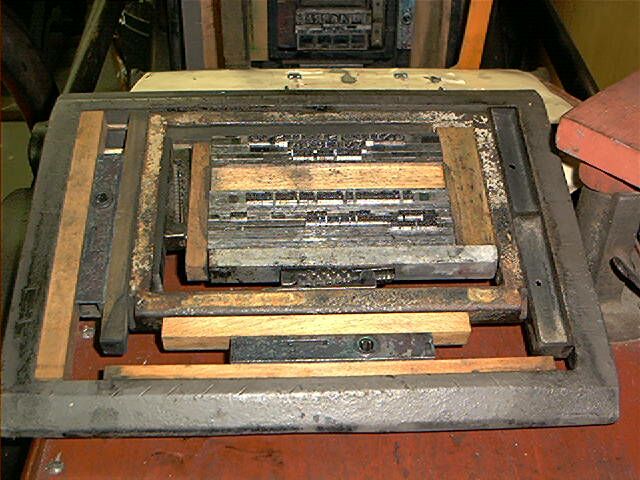
This particular "shell" is Design No. 1. I will leave this "Form"(the assemblage of type that forms this "shell") locked in the chase for future runs later this month. Ultimately the Form will be released from the Chase, wrapped with type string and stored in a galley rack. Even though these chases a made of wrought iron, and quite thick (and heavy!), if the forms are left locked for long enough time, they can warp the chase, which is not a good thing, even if you do have a smithy in town.
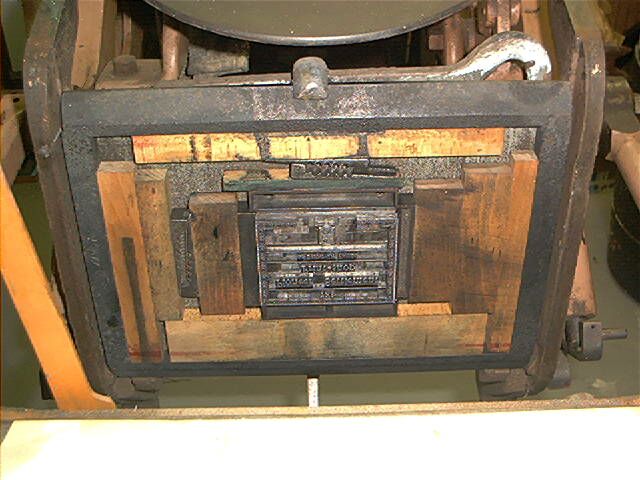
This Form is for the Settlement Print Shop "Visitor's Card". I run this card for special events and Jambourees, usually letting visitors turn the flywheel and pump the treadle of one of the presses, or pump the handle if using one of the iron handpresses. Watching one of these presses in action is like watching a player piano: there are so many cams and links and things moving at one time that one can appreciate the feat of engineering these marvels really are. Remember that to this day the finest of precision typography is still performed on presses such as these iron machines, capable of constant registration rivalling the most up to date offset machines, using a basic method practiced for over half millenia: metal type held in a Form, covered with ink and pressed into a paper.
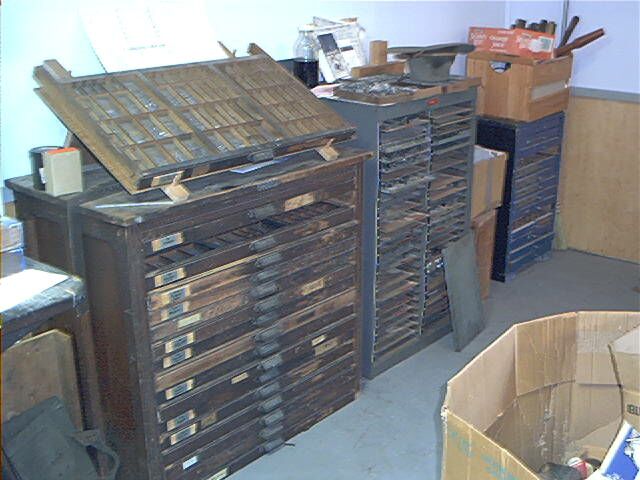
This particular Type Cabinet is an early Hamilton, built in the 1870s. You can see one of the job cases, in this case a full California Type Case, set on top in position for composing or decomposing. The backs of these particular trays are made of one single piece of milled wood. Later trays were backed with wood ply, still later tempered compressed masonite. The iron case "pulls" are often collected in and of themselves. Personally, i prefer them on the cases . . . not in collections. And these cases belong in drawers, not hanging on walls with little thimbles and cheezy nick-knacks in them. Fortunately that "80's" trend has just about run it's course. Beside this case is the galley, and beyond it is a small quarter case roll-away cabinet used for certain sorts and "ding-bats" and leads smaller than 40 pt. We also use the older Upper and Lower type cases, common to the prior century.
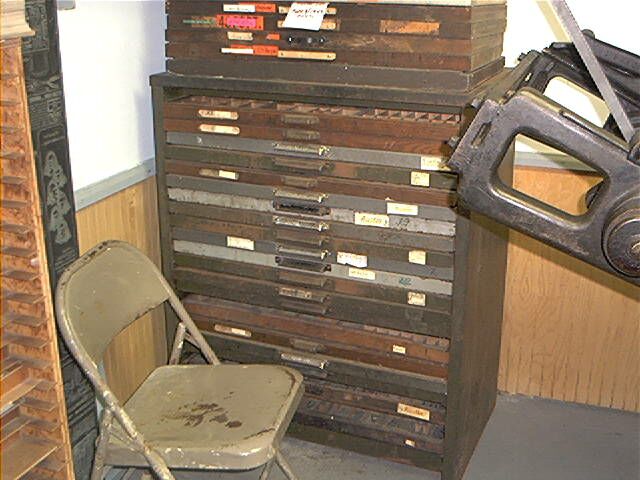
This is a much newer, more modern type cabinet, dating to about the first world war. These cases hold larger fonts, some title fonts and woods. These were donated cases that still must be sorted thru. Usually these cases are loaded with mixed fonts which are as old as the cabinets.
Often, old and unused metal type fell prey to lead moulds for toy tin soldiers during the turn of the last century (1900). A recent inventory taken of some donated type trays actually revealed one such tin soldier, resting with the quads and spaces, obviously cast in lead antimony. It was a WW1 doughboy sporting a gas mask and rifle with bayonette affixed! The "Doughboy" is now the print shop mascot. Another type tray contained a "Dog Tag" from the USAEC, 1918.
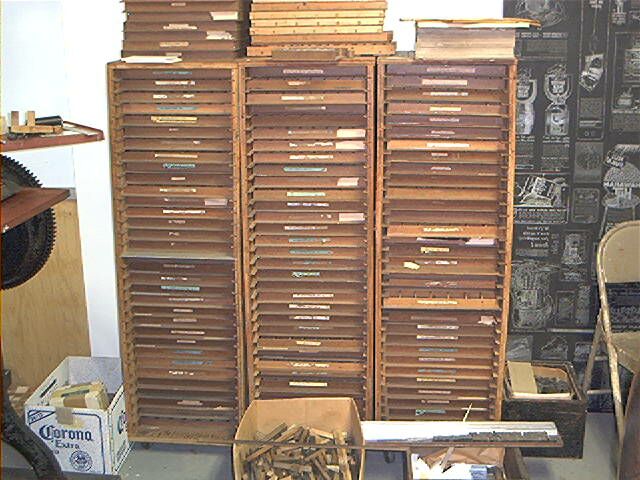
I don't know who made these cases or the rack that holds them, but they did a magnificent job. We think it was owned by the Volusia County Sentinel, and held small "job" fonts, which are fonts of lower type count, usually specialty faces used for greeting cards and special occasions, as opposed to "book fonts" which contain much larger numbers of each letter, number and figures, used for printing books, newsletters, and jobs involving much more than simple greetings or letterheads.

The paper stock is cut by the ream or half ream, held in place by a manual clamp (wheel at top forces the clamp) while a large lever drops the two foot long blade. It takes two hands to operate each function of this machine, which is a safety feature. This keeps the operator's fingers away from the blade.

These are shells for WA6PRL's cards, awaiting the second run which will apply the call letters, name and address information. Each one of these cards are manually printed on these presses, one at a time at the rate of 10 impressions per minute on average. They can do up to 15, but for registry runs, one must pause occasionally to check the position of the gauge pins to make sure nothing slipped. If you tape them down, they won't easily slip. You can see these gauge pins holding a card two images down.
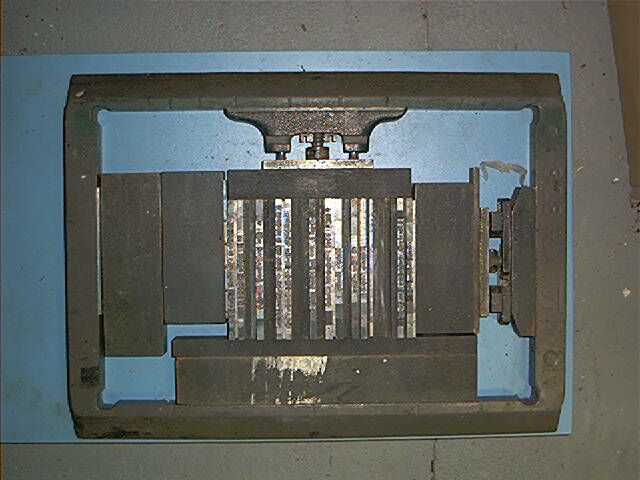
This is an interesting form, which came locked and mounted into one of the presses donated to the Florida Pioneer Settlement of the Creative Arts. It is for a Bed and Breakfast somewhere in Pierson or Seville, Fl. I kept it loosely locked and set on the blue formica board so visitors might have a close view of a locked form;
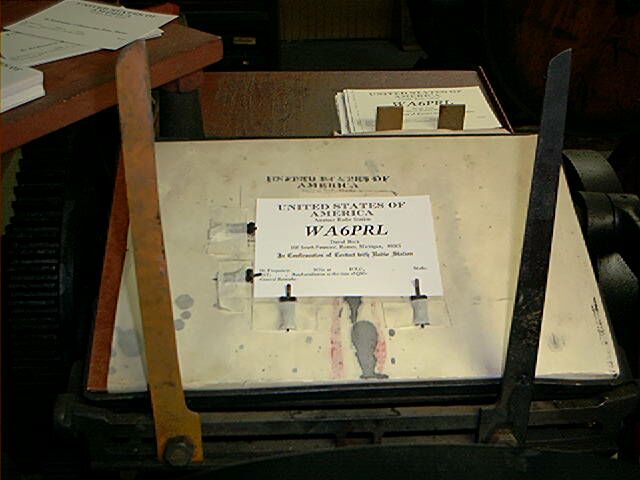
Showing gripper bars on each side of the tympan, one orange and one grey. I took the orange one from the other 8x10 for use here, the original is being straightened. Note the gauge pins, 2 on the bottom and 2 on the side, which hold the card in place. Normally a clean tympan sheet is used, but at the time of the photo shoot, makeready from a prior job had to be used. Actually, not too untypical in a rural swamp-town print shop. Waste not, want not. (oh, but look out for those gauge-pin holes when you fast-feed!)

When the sun shines in, makes for a very cheery place. The view looks onto the wash-room, a sort of turn of the century version of a laundromat. I have to use the outside laundry tub to wash up. Water has to be fetched and bailed. This was part of community life in a small Florida town of 1890. Our print shop is actually one of the better equipped printeries, most small town presses were a single small press and a few trays of type. The crowning touch would be a pot bellied stove with coffee on the brew! And the sound of Phillips code on the sounder. Some print shops also doubled as the local news agency, and had a wire or wireless connect to the outside world. 1920's Florida was very involved in wireless communication especially due to the widespread citrus industry.
The Pioneer settlement has it's telegraph station currently set up in the train depot, not on line at this point.

This is a sample of one of the business card sized Amateur Radio calling
cards, commonly referred to as "Eyeball QSL Cards". Handy thing to have
at the Hamfest. I find myself constantly writing down my call and contact
information on whatever shred of paper i have on hand. These not only
look like they come right out of the '40s, but also can serve to convey
to your recipient the idea that, hey, maybe you DO know your stuff.
. . . even if you don't.
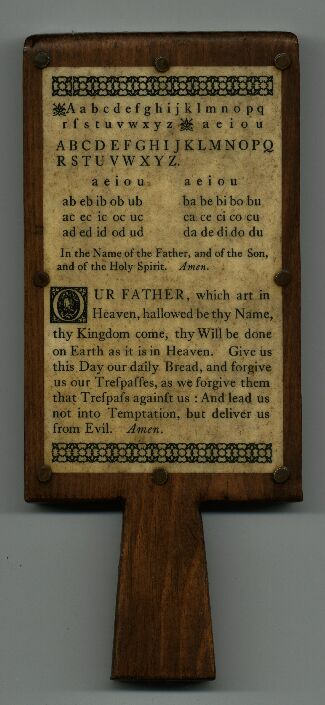
($15.00 plus shipping)
This was America's very first Public School "Textbook". Although used in the
old world since the dark ages, the Hornbook was used in the American Colonies
largely as a result of the first Public School legislation enacted on our
shores: the 1647 Massachusettes "Old Deluder Law", which was intended
. . . to encourage reading and to prevent learning from "being buried in the
grave of our fathers", the Massachusetts law ordered that every town having
fifty householders or more should at once appoint a teacher of reading and
writing and pay him out of town funds, and that every town having one
hundred householders or more must provide a school good enough to prepare
young men for entering a college or pay a penalty for failure to do so.
The law began by stating that in the past it had been "one chief point of that old deluder, Satan, to keep men from a knowledge of the Scriptures . . . by keeping them (the Scriptures) in an Unknowne Tongue . . . "
The Hornbook was simply a printed grammatic and numeric sampler, usually including upper and lower case letters, cyphers (numbers), the "Exorcism", and the Lord's Prayer. This was affixed to a wooden board with a handle, and covered with boiled and pressed antler horn, which was nailed over the printed paper to protect it from the elements, dirty fingers, and probably to provide the teacher with a ready instrument of authority to apply to the backside of wayward pupils.
Our Hornbooks are made in the authentic manner, only the typeset printed "sampler" is decoupaged, mostly due to the deteriorating nature of actual processed antler horn, which rots. Our Hornbooks are just as durable, and will last longer than the 30 - 50 years the originals lasted. I have modelled our version after the original Bay Colony Hornbooks, utilising the authentic Caslon "Old Style" #337 typeface used in the Colonies almost exclusively, up to 1800. Note the long "s"(that looks like "f") in certain words. We use authentic hand-made papers as well (linen or cotton "laid" papers), and of course all printing is executed on our letterpresses by your humble Servant.
The Hornbook measures approximately 7" long and 3.5" wide, and can be wall mounted, or can stand on it's handle. A unique example of our founding fathers' concern for academic standards even in the frontiers of a New World. A great historical piece to display in a school library, or a simple gift for that person with a penchant for things authentically historic and/or Early American.
The woods used are either pine, oak or poplar. The paper itself slightly "foxes" under laquer, presenting a very vintage look.
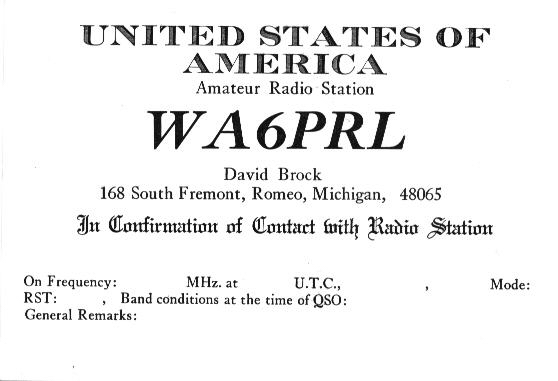
This is a sample of one of the QSL Card designs. In fact, at this point it is the only design, but more are planned, and as they become reality, they will be posted. I would like to keep these card designs formatted after the several 1920's thru 1940's typeset designs, although "art" cards from that era are also planned.
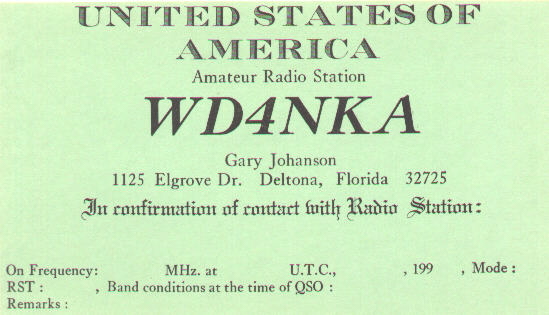
This is just another version of the same card, only different callsign, using another colour of stock (paper). Although this particular mint green is no longer available (this particular stock was from a 50 year old ream i found!) there are other colours available. Huh, i have to go to the supply place and see just what those choices are, but there is a variety. I would recommend keeping with muted colours, however.
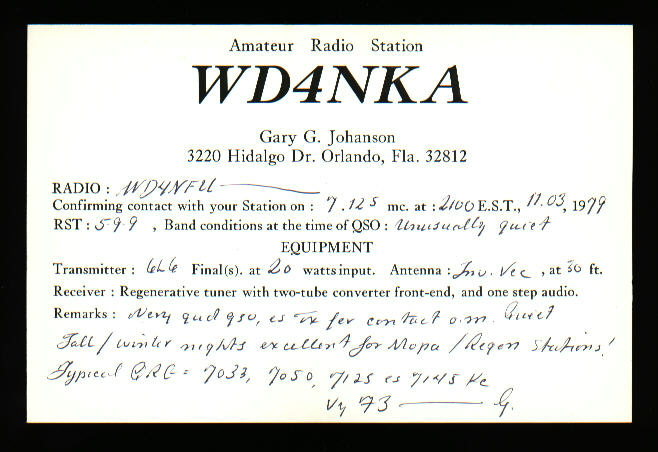
This was the card that started me off making vintage QSL typeset designs. This card is actually copied from a QSL of somewhere around 1931 (probably saw it on the wall of some OT'ers shack). At the time i was running my 6L6 mopa and a regen/hi-band converter (Regenerodyne) for receive. This is another example of a text variation. I filled the card out so you might get an idea of what these looked like when received in the mail. I still use Regenerodynes as my main station receiver and mopa's as the usual transmitter fare.